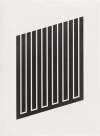Minimalism
Discover art for sale. Buy and sell Minimalist prints & editions online. Minimalism, renowned for its emphasis on reduction and purity, uses minimal elements to create maximum impact.
Art for sale
Movement Overview
Minimalism emerged as a significant art movement in the post-World War II era, predominantly in the United States. Key figures like Frank Stella, Donald Judd, and Agnes Martin redefined art with their focus on simplicity and use of monochromatic colours and geometric forms. This movement, characterised by its basic, unadorned style, sought to strip art down to its fundamental aspects, challenging traditional art forms. Its influence is still presently felt in various art and design fields, setting the stage for contemporary and postmodern art practices.
Minimalism developed as a reaction against the emotional intensity and gestural artistry of Abstract Expressionism, its predecessor. The movement initially manifested through the works of artists like Frank Stella, whose Black Paintings series symbolised a radical departure from more expressive art forms. These artists sought to remove personal narrative and metaphor, focusing instead on objectivity and reductionism in their art.
The foundational philosophy of Minimalism revolved around the concept of “less is more.” This approach was about stripping art down to its essential elements – form, colour, and material. The artists, including Donald Judd, Ellsworth Kelly and Dan Flavin, emphasised creating works that were self-referential, devoid of illusion or representation. Their works, characterised by simplicity and precision, often consisted of geometric shapes and industrial materials, challenging traditional notions of sculpture and painting.
Significant early exhibitions, such as Primary Structures at the Jewish Museum in 1966, marked the official recognition of Minimalism as a distinct art movement. These exhibitions showcased works that exemplified the movement's core principles, including repetition, neutrality, and an emphasis on space and light.
While initially confined to visual arts, Minimalism's influence soon extended to architecture, design, and music, reflecting its foundational ethos across various creative domains.
Minimalism marked a pivotal shift in the art world, advocating for simplicity and objectivity. This movement represented a vast departure from the expressive and subjective art that preceded it, focusing instead on the essential elements of art—form, colour, and materials. Minimalism's philosophy centred on the idea that art should not be about the representation of external reality, but should instead focus on the artwork's material and spatial presence.
Artists within the Minimalism movement, such as Donald Judd, Agnes Martin, and Frank Stella, sought to strip away the metaphorical and narrative elements from their work, creating pieces characterised by geometric abstraction and simplicity. They embraced the use of industrial materials and repetitive forms, aiming to create art that stood independently of any references to the outside world or the artist's own emotions.
A quintessential example is seen in Judd's Untitled series of box sculptures. These works exemplify the minimalist ethos with their clean lines, simple surfaces, and focus on the purity of form and space.
The movement's emphasis on minimalism, functionality, and clarity of form has resonated across decades, continuing to inspire artists and designers seeking to capture the essence of an idea in its most distilled form. Minimalism, in its purest sense, remains a testament to the power of simplicity and the beauty of reduction.
Some of the most famous Minimalism artists include Donald Judd, Dan Flavin, Agnes Martin, Carl Andre, Ellsworth Kelly, and Frank Stella.
Frank Stella, an icon of Minimalism, began his artistic journey with an education at Phillips Academy and later at Princeton University. His early career was marked by a bold departure from the expressive brushwork and subjectivity of his predecessors. Instead, he focused on the physical properties of painting, exploring the interaction of shape, colour, and composition.
One of Stella's most significant contributions to Minimalism is his Black Paintings series. Created in the late 1950s, these works consist of uniform black stripes separated by very thin lines of unpainted canvas. The simplicity and repetitive nature of these works emphasise the flatness of the canvas and reject any illusion of depth, challenging traditional notions of what a painting could be. This radical approach was groundbreaking, demonstrating a rigorous consistency that became a hallmark of Minimalist art.
A hallmark technique in Minimalism is the use of industrial materials and processes. Judd, for example, employed commercial fabrication techniques to create his iconic untitled stacks and boxes, challenging the notion of the artist's hand in the creative process. Stella's work, with its uniform, geometric patterns, exemplified the movement's emphasis on simplicity and objective form.
Minimalism also intersected with conceptual art, where the idea or concept behind the work took precedence over its aesthetic or material composition.
Drawing from the legacy of pioneers like Frank Stella, who was influenced by Josef Albers, Hans Hofmann, and Jasper Johns, Minimalism has adapted to become even more expressive and accessible.
As Minimalism has evolved, it has embraced digital technology and new media, broadening its expressive scope and accessibility. This modern adaptation of Minimalism can be seen in the works of contemporary artists like Tadao Ando, whose architectural designs reflect minimalist principles similar to Judd’s through his use of space and natural elements.
Other artists like Yayoi Kusama are also continuing to outline new dimensions in Minimalism. Her work, known for its mesmerising, repetitive patterns, introduces a unique sensory experience into the minimalist canon. Kusama's art transcends traditional confines by incorporating elements of psychology and personal narrative. This blend of introspection and visual simplicity marks a new evolution in the minimalist aesthetic.
We connect buyers and sellers of original contemporary and modern prints, facilitating discreet, independent, investment led private sales. Fixed, clear and mutually agreed upon between both parties - simple, safe and secure.
MyArtBroker, 55-56 Russell Square, London WC1B 4HP (by appointment only)
875 Washington St, New York, NY 10014, United States (by appointment only)
- © 2025 MyArtBroker. All rights reserved.
- Privacy Policy
- Cookie policy
- Website terms of use
- Terms and conditions





